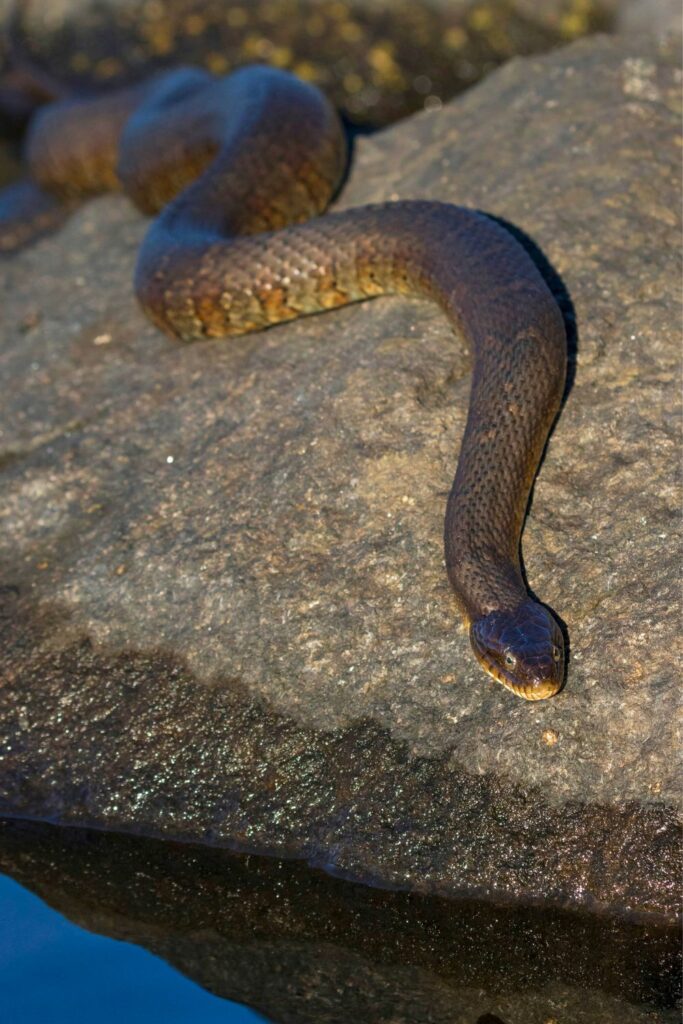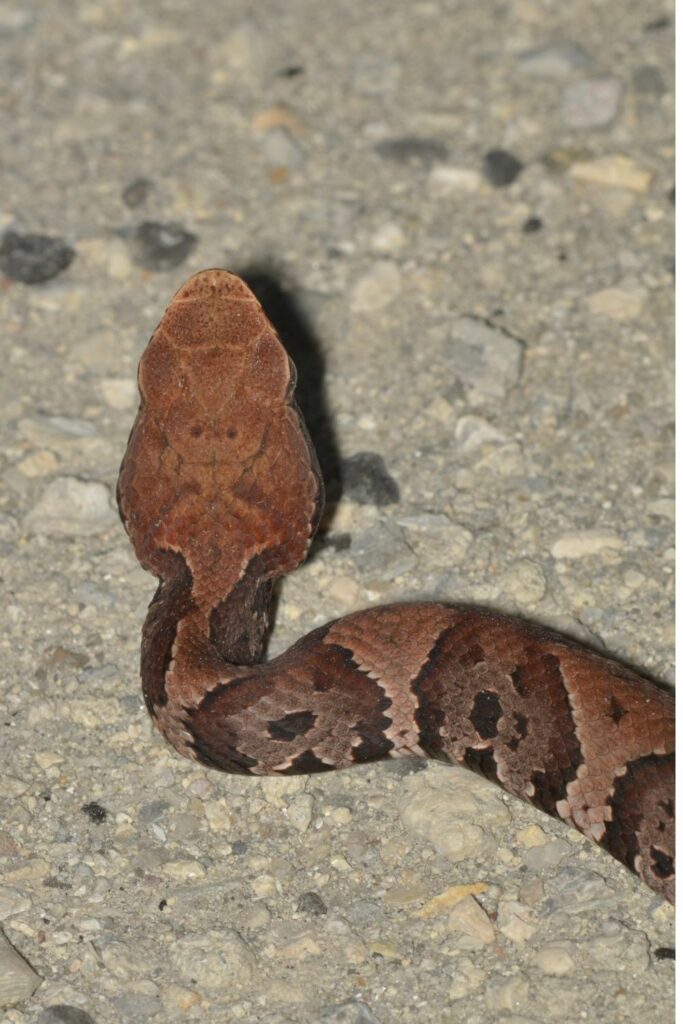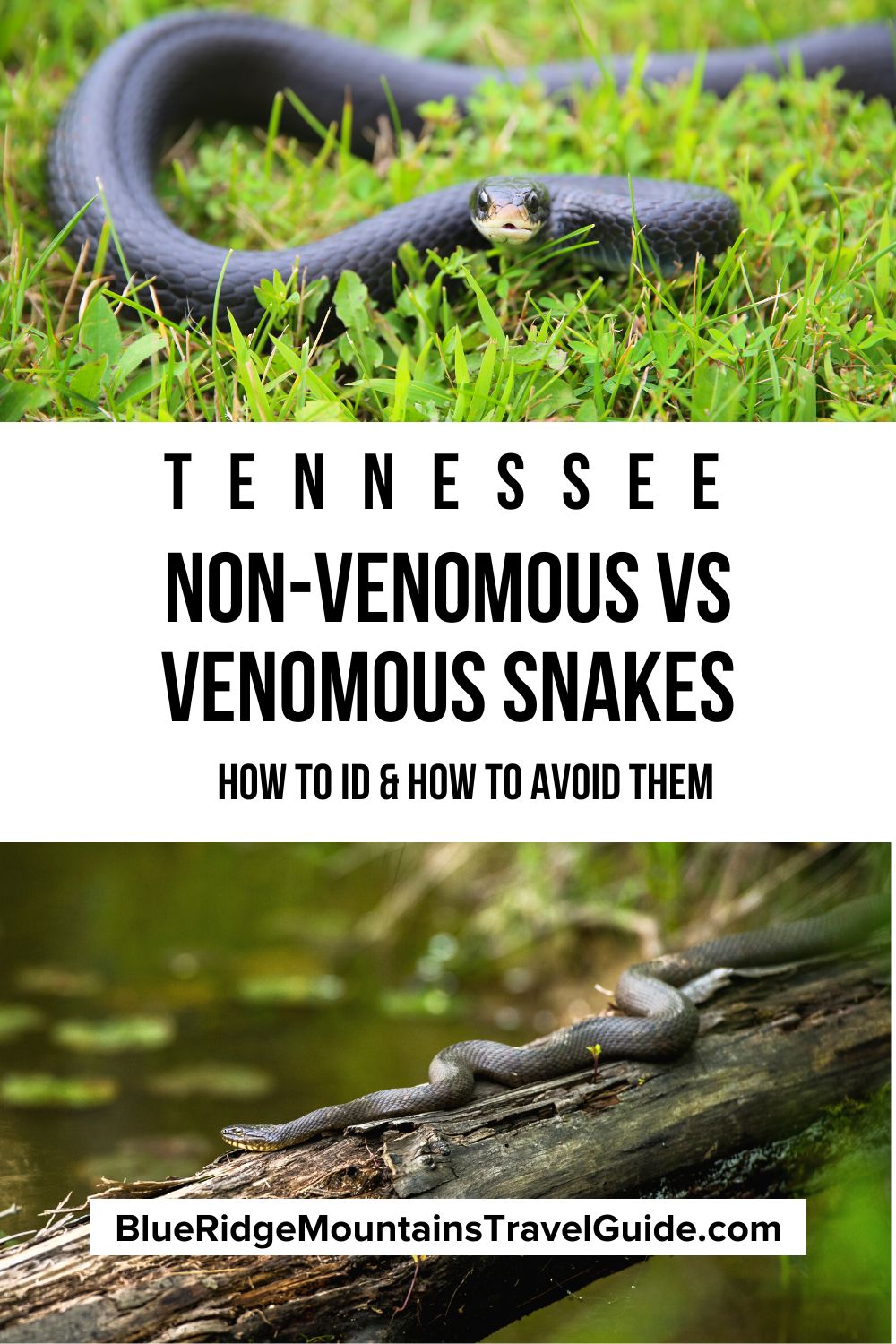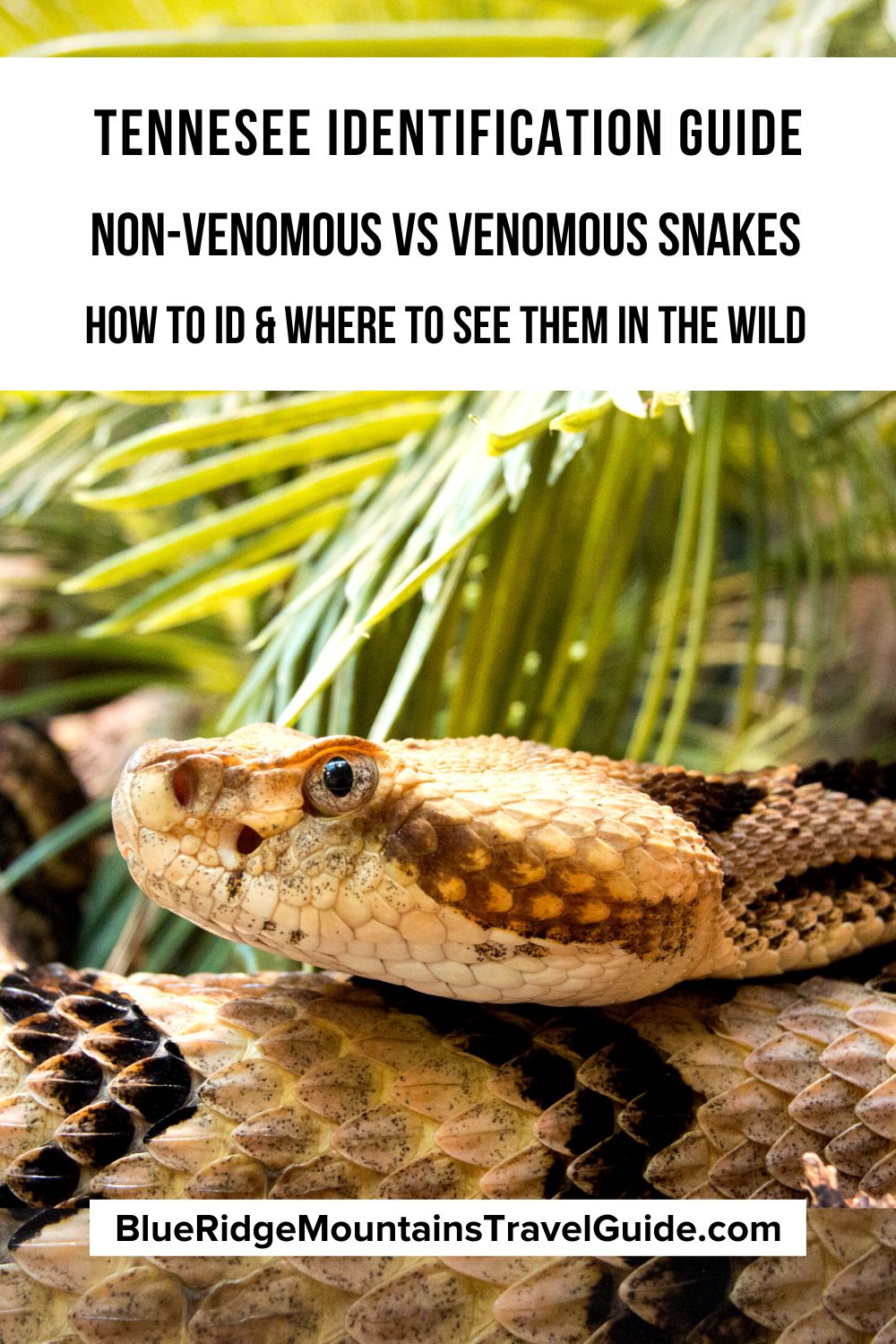A lot of us have an unhealthy fear of snakes, presuming that they’re all human-killing machines bent on a slithery path of destruction.
But that simply isn’t the case, despite what local folklore may have led you to believe.
The truth is that most snakes are non-venomous (80%, to be exact). And, of the 20% of snakes that are venomous, only around 1/3 of those species have venom toxic enough to do serious damage to a person.
With Tennessee snakes, these percentages are even more in our favor. There are only 4 types of venomous snakes in Tennessee, with the other 28 species of snakes being non-venomous (87.5%).
Whether it’s snakes in West Tennessee, snakes in Middle Tennessee, or snakes in East Tennessee (they’re often categorized into these regions), the venomous species don’t even rank in the Top 5 most common snakes in TN.
In other words, any snakes we see in Tennessee are more thank likely going to be little to no threat to us at all.
Read on to learn loads of fascinating facts and distinguishing info that will make identifying snakes– particularly those “poisonous” snakes– in TN a lot easier.
By the end, perhaps we can all learn to relish the thought of seeing snakes in the wild (from a safe distance, of course).
Many of them have absolutely wild colors and patterns, not to mention some of the coolest moves in the animal kingdom!
READ MORE: Non-Venomous vs Venomous Snakes in Virginia (ID Guide)

Non-Venomous vs. Venomous Snakes in Tennessee Guide
- Pygmy Rattlesnake (Sisturus miliarius)
- Timber Rattlesnake (Crotalus horridus)
- Eastern Copperhead (Agkistrodon contortrix)
- Northern Cottonmouth (Agkistrodon piscivorus)
- Gray Rat Snake (Pantherophis spiloides)
- North American Racer (Coluber constrictor)
- Common Water Snake (Nerodia sipedon)
- Dekay’s Brown Snake (Storeria dekayi)
- Eastern Garter Snake (Thamnophis sirtalis sirtalis)
- Eastern Black Kingsnake (Lampropeltis getula)
- Ring-necked Snake (Diadophis punctatus)
- Eastern Hog-nosed Snake (Heterodon platirhinos)
READ MORE: Non-Venomous vs Venomous Snakes in North Carolina (ID Guide)
Tennessee Snake Identification: Non-Venomous vs Venomous
Tennessee has four species of venomous snakes, and all of them are pit vipers. Pit vipers have some very distinct characteristics that make identifying them fairly simple.
- Pit vipers have notably triangular-shaped heads.
- They have heat-sensing pits between their nose and eyes.
- Those eyes are cat-like, with slit-shaped pupils.
- Their bodies are stockier than other snakes in the state.
That being said, there are some non-venomous snakes in Tennessee that are commonly mistaken for similar-looking venomous snakes.
This often results in a dead snake, which is not good. It’s also illegal in Tennessee to kill snakes unless they pose immediate, life-threatening danger to someone.
So it’s good to know how to tell the difference between non-venomous and venomous snakes.
Becoming familiar with common species like hog-nosed snakes (which are often mistaken for pygmy rattlers), the water snakes in Tennessee (often mistaken for water moccasins), and baby black racers (often mistaken for copperheads) might help to save a few snake lives.
READ MORE: Non-Venomous vs Venomous Snakes In Georgia (Identification Guide)
Venomous Snakes in Tennessee

1. Pygmy Rattlesnake
Sisturus miliarius
One of two types of rattlesnakes in Tennessee, the pygmy rattlesnake is the smallest of the venomous snakes in the state.
It reaches a maximum of two feet long, with dark-colored blotches, and the scales at the tip of its tail are adapted to form a rattle. In reality, the rattle makes a sound more like a buzzing insect.
These snakes are only found in the western part of the state, but they live in a variety of habitats, including forests, flatlands, and sandhills.
Despite their small size, they do have venom powerful enough to be fatal, but they’re not as potent as the other rattlesnakes in Tennessee.
These beautiful snakes feed mainly on frogs, lizards, and mice.
READ MORE: 20 Beautiful Birds of Tennessee

2. Timber Rattlesnake
Crotalus horridus
Timber rattlesnakes, the largest venomous snake in TN, can reach five feet long and can be found throughout the state.
As their name suggests, they are forest dwellers that like south-facing slopes with rocky landscapes.
These snakes have thick bodies with dark and light brown splotches, and they most certainly have a rattle. I’ve been warned off by one before, and I hadn’t even seen the snake yet!
It was the mating season (in late summer) when I had my first timber rattler encounter, and I’ve since learned that this is the time we are most likely to see them.
Timber rattlers feed mostly on rodents, which makes them an asset in controlling those populations. But this is one species of Tennessee snakes we should definitely give a wide berth!
READ MORE: The Tennessee Legend of the Bell Witch Haunting
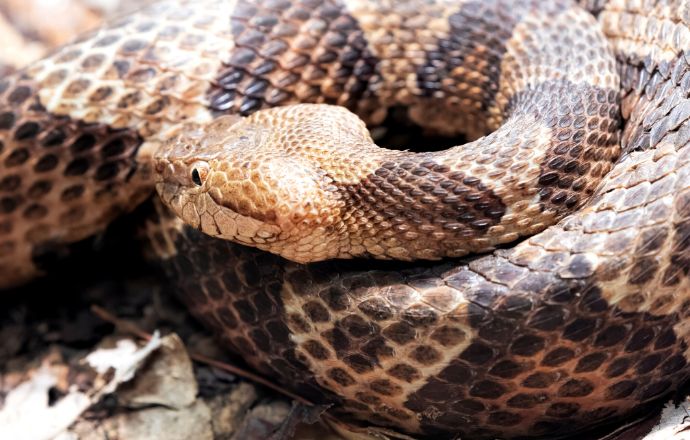
3. Copperhead
Agkistrodon contortrix
There are actually two subspecies of copperheads in Tennessee– the southern copperhead in West Tennessee and the northern copperhead in the rest of the state.
Mature copperheads are usually between two and three feet long, with dark brown hourglass-shaped bands on their backs.
They also have copper-colored heads, and young copperheads have a distinctive yellow tip on their tail to help lure prey.
Copperheads tend to stay out of open areas, opting for forests with lots of rocks and leaf litter. They blend incredibly well into a pile of brown leaves, so they occasionally get stepped on (and people get bitten in response).
Copperheads love to eat mice, and they also feed on birds, lizards, other snakes, amphibians, and cicadas.
READ MORE: The 15 Best Things to Do in Lookout Mountain GA/TN

4. Northern Cottonmouth
Agkistrodon piscivorus
A nightmare of my childhood, cottonmouths/water moccasins were extremely prevalent in my native Louisiana. But in Tennessee they only inhabit the western part of the state, particularly around swampy areas.
Water moccasins can be aggressive, dangerous snakes. For that reason, many people paint all water snakes with the same moccasin brush.
But the other water snakes in Tennessee (and most of the US) aren’t venomous at all!
Aside from the characteristic pit viper triangle head and slit eyes, one way to tell a cottonmouth from other water snakes is their buoyancy. Cottonmouths tend to swim high in the water, with most of their bodies above the surface.
Another distinguishing characteristic is their tendency to show their white mouth (“cottonmouth”) as a warning sign.
Large cottonmouths can grow to over six feet long. They have very thick bodies, which usually appear either black or dark brown, with irregular dark blotches.
READ MORE: 20 Ways to Celebrate Christmas in the Smoky Mountains (NC & TN)
Common Snakes in TN
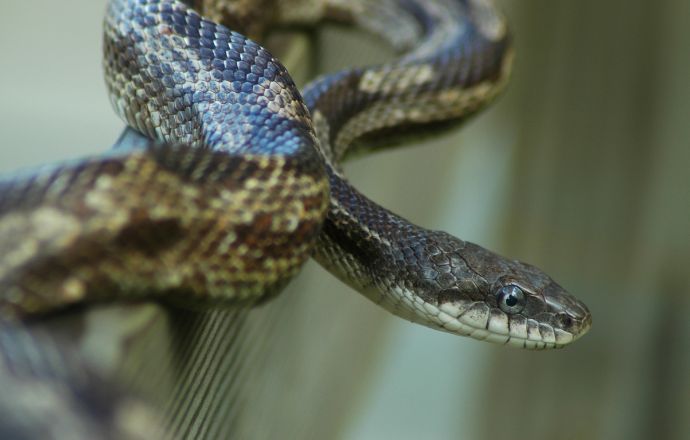
5. Gray Rat Snake
Pantherophis spiloides
One of two species of rat snakes in Tennessee, the gray rat snake can be found from the western edge of the Appalachian Mountains through the state.
They are also commonly known as chicken snakes in Tennessee.
Gray rat snakes are slender, but very long, and commonly exceed six feet. They spend most of their time on the ground, but they are skilled tree climbers if they sense lunch is waiting up in a nest.
Rat snakes are commonly found around barns and sheds, where they can find rodents to eat. They also love to eat eggs.
While gray rat snakes are non-venomous, they will bite if cornered or handled. They also release a strong musk when people pick them up (which is not good snake etiquette).
READ MORE: The 15 Best Great Smoky Mountains Campgrounds to Visit

6. North American Racer
Coluber constrictor
The North American racer, also known as the eastern racer, can easily get confused with the other black snakes in TN (a.k.a. black rat snakes).
Both snakes are long and slender, and they move incredibly quickly when they’re on the go. But black racers are solid black, while black rat snakes have white bellies.
The North American racer is a very common snake, and has an ill-founded reputation for chasing people.
However, they will get aggressive if cornered, and won’t hesitate to deliver non-venomous bites to defend themselves.
Even though the eastern racer is identified as a Coluber constrictor, they don’t squeeze their prey to death. They simply swallow them whole. They love rodents, amphibians, smaller snakes, and insects.
There are two subspecies of North American racers in Tennessee– northern black racers in the east, and southern black racers in the west. Both of them tend to inhabit open fields near woodland edges.
READ MORE: Exploring Chickamauga and Chattanooga National Military Park in Lookout Mountain
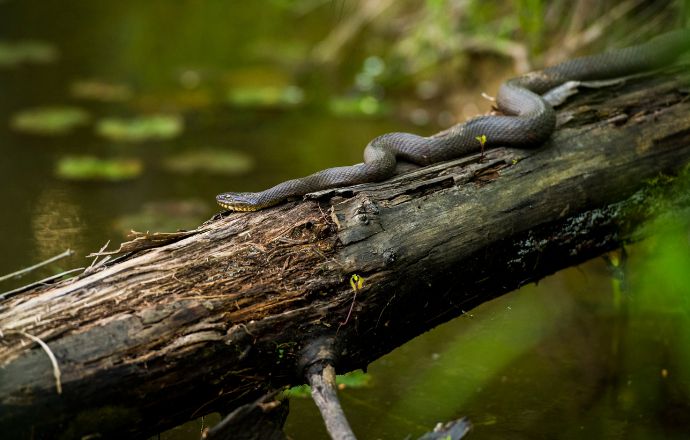
7. Common Water Snake
Nerodia sipedon
Also known as the northern water snake, these are the most common water snakes in Tennessee (and in the rest of the United States).
They’re found most extensively in the Eastern US and Midwest parts of Tennessee, but are seen throughout the state.
Common water snakes adapt to versatile aquatic environments, but are happiest in slow-moving or still water. They especially like to sun themselves on rocks at the banks of ponds and lakes.
These snakes average a little over three feet long, with dark bands over coppery tones and thick bodies.
Northern water snakes feed on fish and amphibians, swallowing them whole.
Though they’re commonly mistaken for copperheads and water moccasins, they are not venomous. But they will bite when agitated and/or threatened.
READ MORE: The Ultimate Ocoee River Rafting Guide
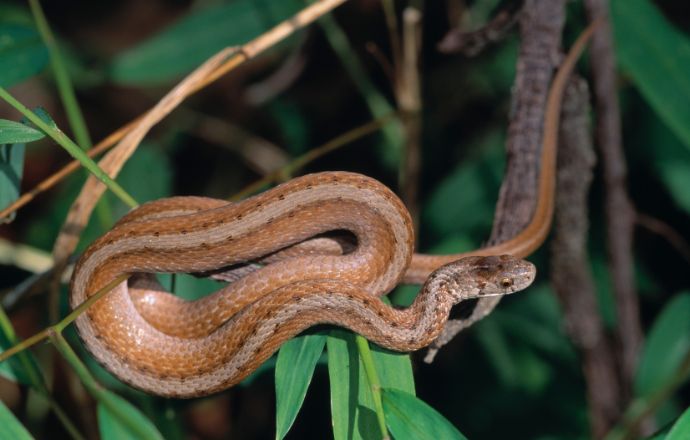
8. Dekay’s Brown Snake
Storeria dekayi
There are two subspecies of Dekay’s brown snakes in Tennessee.
The midland brown snake occurs throughout the state, while the northern brown snake (ironically) is found in the southeastern corner of the state.
Dekay’s brown snakes measure around a foot long, and are typically brown and/or gray with rows of dark spots. The top of their heads is dark, and their bellies are lighter colors, like yellow or tan.
They can be found in just about any environment, from wetlands and hardwood forests to empty urban lots. But they’re most often hidden among rock piles, wood piles, or garden mulch.
These harmless little snakes feed on earthworms, snails, spiders, and soft-bodied insects, with big meals sometimes coming in the form of amphibians or fish.
READ MORE: What is Bluegrass? The History & Evolution of Appalachian Music
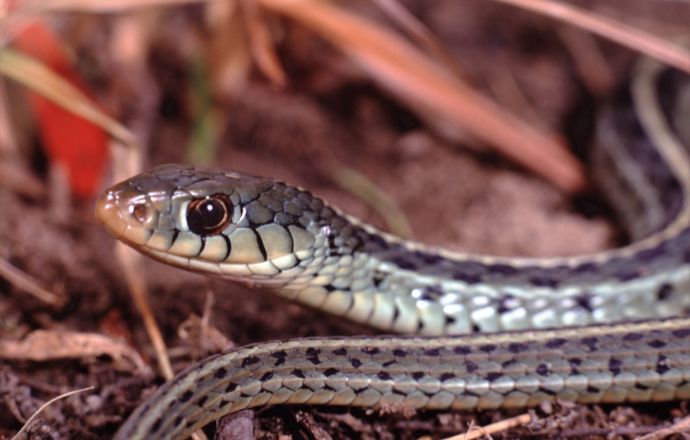
9. Eastern Garter Snake
Thamnophis sirtalis sirtalis
Tennessee’s subspecies of the common garter snake is called the eastern garter snake. It’s one of the most prevalent of all snakes in the state.
They usually measure around 18 inches to 2 feet long, with slender bodies.
Their color patterns vary, but eastern garter snakes usually have 3 light-colored stripes, with one down each side and one down the center of the back.
Eastern garter snakes like living near wet areas, including ponds, lakes, drainage ditches, or damp woods. They primarily eat frogs and toads (as well as their tadpoles), but salamanders and fish are also on the menu.
One of our favorite interesting snake facts is that these are often misconstrued to be “garden” snakes. But they’re actually named after their stripes, which resembled the garters historically used to hold up men’s socks!
READ MORE: The Appalachian Culture & History of the Blue Ridge Mountains

10. Eastern Black Kingsnake
Lampropeltis getula
The most widespread of the three subspecies of king snakes in Tennessee, the eastern black kingsnake is found everywhere in the state except for the northeast section in the Blue Ridge Mountains.
One of the larger black snakes in Tennessee, this kingsnake can reach about four feet long. They have thin, speckled crossbars across their black dorsal bodies, and are sometimes mistaken for black rat snakes and black racers.
The eastern black kingsnake is considered totally harmless to humans. They’re constrictors that go after small rodents, birds, eggs, lizards, and other snakes.
They’re famed for being able to feed on venomous snakes, so they’re good snakes to have around your property!
Kingsnakes are found in most environments, especially forests, fields, shrubbery, and even urban spaces. But they really love streambanks and moist spots.
READ MORE: 40 Facts About the History of the Banjo (From Africa to Appalachia)
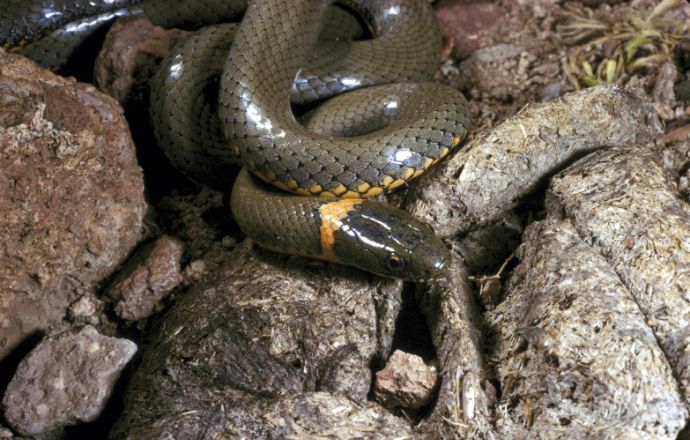
11. Ring-necked Snake
Diadophis punctatus
The northern ring-necked snake occupies the eastern part of Tennessee, while the Mississippi ring-necked snake lives in the western half.
These two subspecies interbreed where their habitats overlap, so we’re simply calling them ring-necked snakes.
Ring-necked snakes are fairly small and thin, with a maximum length of 15 inches. They have dark backs, bright yellow bellies, and an orange ring around their necks that form a chin strap.
Ring-necked snakes can be found in just about any ecosystem, but they prefer moist forest floors and have a particular penchant for hiding under things.
They eat small things like earthworms and insect larvae, as well as little salamanders, lizards, and even tiny snakes.
READ MORE: The 15 Best Things to Do in Great Smoky Mountains National Park

12. Eastern Hog-nosed Snake
Heterodon platirhinos
This non-venomous snake in Tennessee is commonly mistaken for the pygmy rattlesnake, because it has a similarly short, stout body and an upturned nose that feigns the look of a pit viper.
It tends to have a large head and a dark back, with an evident background color and a lighter-colored belly. Young snakes can have much more vibrant color patterns.
Eastern hog-nosed snakes are found throughout the state of Tennessee, and neighboring states such as Georgia, North Carolina, and Virginia. They live in loose, sandy soil where they can burrow, including floodplains and on hillsides.
Hog-nosed snakes are often killed because they have some crazy defensive behaviors, such as flattening their heads and necks, hissing loudly, and striking out.
They also tend to roll over, regurgitate, and defecate when cornered, all while releasing an unpleasant musk. –by Jonathon Engels; lead image via Canva


